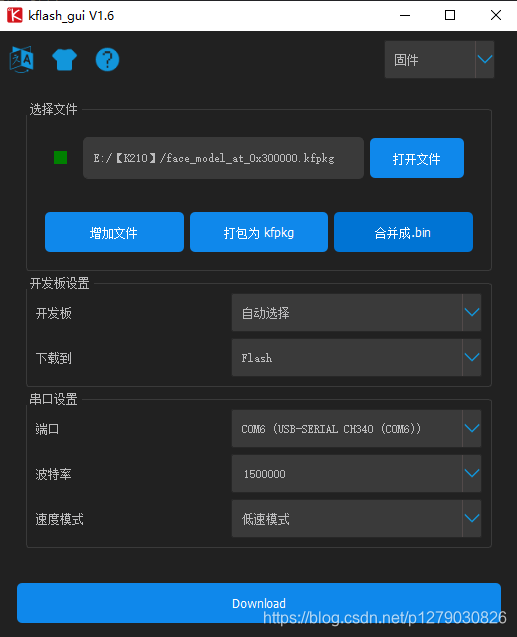一、人脸检测:
1、烧录模型:
在 模型下载 下载 face_model_at_0x300000.kfpkg 这个模型文件,使用 kflash_gui 下载模型到 Flash。

2、示例测试:
连接开发板,拷贝以下示例代码到 MaixPy IDE 运行,参考:【K210学习笔记】#Maixpy#(1)Maixpy IDE安装与使用
示例脚本:demo_find_face.py
import sensor, image, lcd, time
import KPU as kpu
import gc, sys
def lcd_show_except(e):
import uio
err_str = uio.StringIO()
sys.print_exception(e, err_str)
err_str = err_str.getvalue()
img = image.Image(size=(224,224))
img.draw_string(0, 10, err_str, scale=1, color=(0xff,0x00,0x00))
lcd.display(img)
def main(model_addr=0x300000, lcd_rotation=0, sensor_hmirror=False, sensor_vflip=False):
try:
sensor.reset()
except Exception as e:
raise Exception("sensor reset fail, please check hardware connection, or hardware damaged! err: {}".format(e))
sensor.set_pixformat(sensor.RGB565)
sensor.set_framesize(sensor.QVGA)
sensor.set_hmirror(sensor_hmirror)
sensor.set_vflip(sensor_vflip) # 开启摄像头垂直翻转
sensor.run(1)
lcd.init(type=1)
lcd.rotation(lcd_rotation)
lcd.clear(lcd.WHITE)
anchors = (1.889, 2.5245, 2.9465, 3.94056, 3.99987, 5.3658, 5.155437, 6.92275, 6.718375, 9.01025)
try:
task = None
task = kpu.load(model_addr)
kpu.init_yolo2(task, 0.5, 0.3, 5, anchors) # threshold:[0,1], nms_value: [0, 1]
while(True):
img = sensor.snapshot()
t = time.ticks_ms()
objects = kpu.run_yolo2(task, img)
t = time.ticks_ms() - t
if objects:
for obj in objects:
img.draw_rectangle(obj.rect(), color=(255,0,0), thickness=3)
img.draw_string(0, 200, "t:%dms" %(t), scale=2)
lcd.display(img)
except Exception as e:
raise e
finally:
if not task is None:
kpu.deinit(task)
if __name__ == "__main__":
try:
main( model_addr=0x300000, lcd_rotation=0, sensor_hmirror=False, sensor_vflip=True)
# main(model_addr="/sd/m.kmodel")
except Exception as e:
sys.print_exception(e)
lcd_show_except(e)
finally:
gc.collect()
二、人脸识别:
1、获取机器码:
使用 kflash_gui 下载:key_gen_v1.2.bin 烧录到开发板

烧录后从串口终端获取到机器码:

2、获取人脸识别模型:
进入 MaixHub 下载人脸识别模型:

填入机器码下载:(地址)

下载后得到0x300000、0x400000、0x500000 三个地址的 .smodel 模型文件
3、烧录专用固件:
在 下载站 下载 kmodelv4 支持固件,并用 kflash 烧录。


4、烧录模型:
按照文件名分别烧录到不同的地址:

5、示例测试:
连接开发板,拷贝以下示例代码到 MaixPy IDE 运行,参考:[【K210学习笔记】#Maixpy#(1)Maixpy IDE安装与使用]
示例脚本:demo_face_recognization.py
import sensor
import image
import lcd
import KPU as kpu
import time
from Maix import FPIOA, GPIO
import gc
from fpioa_manager import fm
from board import board_info
import utime
task_fd = kpu.load(0x300000) # 加载人脸检测模型
task_ld = kpu.load(0x400000) # 加载人脸五点关键点检测模型
task_fe = kpu.load(0x500000) # 加载人脸196维特征值模型
clock = time.clock() # 初始化系统时钟,计算帧率
# 设置按键引脚 按下记录人脸
fm.register(board_info.BOOT_KEY, fm.fpioa.GPIOHS0)
key_gpio = GPIO(GPIO.GPIOHS0, GPIO.IN)
start_processing = False
BOUNCE_PROTECTION = 50
def set_key_state(*_):
global start_processing
start_processing = True
utime.sleep_ms(BOUNCE_PROTECTION)
key_gpio.irq(set_key_state, GPIO.IRQ_RISING, GPIO.WAKEUP_NOT_SUPPORT)
lcd.init() # 初始化lcd
sensor.reset() # 初始化sensor 摄像头
sensor.set_pixformat(sensor.RGB565) # 设置摄像头输出格式
sensor.set_framesize(sensor.QVGA) # 设置摄像头输出帧大小,k210最大支持VGA格式
sensor.set_hmirror(1) # 设置摄像头镜像
sensor.set_vflip(1) # 设置摄像头翻转
sensor.run(1) # 使能图像捕捉功能
anchor = (1.889, 2.5245, 2.9465, 3.94056, 3.99987, 5.3658, 5.155437,
6.92275, 6.718375, 9.01025) # anchor for face detect 人脸检测的Anchor
dst_point = [(44, 59), (84, 59), (64, 82), (47, 105),
(81, 105)] # standard face key point position 标准正脸的5关键点坐标:左眼 右眼 鼻子 左嘴角 右嘴角
a = kpu.init_yolo2(task_fd, 0.5, 0.3, 5, anchor)
img_lcd = image.Image() # 创建一个新的图像对象
img_face = image.Image(size=(128, 128)) # 设置图像大小
a = img_face.pix_to_ai() # 将RGB565的图像手动更新到RGB888的区域,供kpu功能使用
record_ftr = [] # 用于存储当前196维特征
record_ftrs = [] # 用于存储按键记录下人脸特征, 可以将特征以txt等文件形式保存到sd卡后,读取到此列表,即可实现人脸断电存储
names = ['Mr.1', 'Mr.2', 'Mr.3', 'Mr.4', 'Mr.5',
'Mr.6', 'Mr.7', 'Mr.8', 'Mr.9', 'Mr.10'] # 人名标签,与上面列表特征值一一对应
ACCURACY = 85 # 人脸匹配分数值定义(判定识别成功)
while (1):
img = sensor.snapshot() # 从摄像头获取图像
clock.tick() # 记录时间,用于计算帧率
code = kpu.run_yolo2(task_fd, img) # 运行人脸检测模型,获取人脸坐标位置
if code: # 检测到人脸
for i in code:
# Cut face and resize to 128x128
a = img.draw_rectangle(i.rect()) # 在屏幕显示人脸方框
face_cut = img.cut(i.x(), i.y(), i.w(), i.h()) # 裁剪人脸部分图片到 face_cut
face_cut_128 = face_cut.resize(128, 128) # 将裁出的人脸图片 缩放到128 * 128像素
a = face_cut_128.pix_to_ai() # 将RGB565的图像转为kpu格式
# a = img.draw_image(face_cut_128, (0,0))
# Landmark for face 5 points
fmap = kpu.forward(task_ld, face_cut_128) # 运行人脸5点关键点检测模型
plist = fmap[:] # 获取关键点预测结果
le = (i.x() + int(plist[0] * i.w() - 10), i.y() + int(plist[1] * i.h())) # 计算左眼位置, 这里在w方向-10 用来补偿模型转换带来的精度损失
re = (i.x() + int(plist[2] * i.w()), i.y() + int(plist[3] * i.h())) # 计算右眼位置
nose = (i.x() + int(plist[4] * i.w()), i.y() + int(plist[5] * i.h())) # 计算鼻子位置
lm = (i.x() + int(plist[6] * i.w()), i.y() + int(plist[7] * i.h())) # 计算左嘴角位置
rm = (i.x() + int(plist[8] * i.w()), i.y() + int(plist[9] * i.h())) # 计算右嘴角位置
# 在相应位置处画小圆圈
a = img.draw_circle(le[0], le[1], 4)
a = img.draw_circle(re[0], re[1], 4)
a = img.draw_circle(nose[0], nose[1], 4)
a = img.draw_circle(lm[0], lm[1], 4)
a = img.draw_circle(rm[0], rm[1], 4)
# align face to standard position
src_point = [le, re, nose, lm, rm] # 图片中 5 坐标的位置
T = image.get_affine_transform(src_point, dst_point) # 根据获得的5点坐标与标准正脸坐标获取仿射变换矩阵
a = image.warp_affine_ai(img, img_face, T) # 对原始图片人脸图片进行仿射变换,变换为正脸图像
a = img_face.ai_to_pix() # 将正脸图像转为kpu格式
# a = img.draw_image(img_face, (128,0))
del (face_cut_128) # 释放裁剪人脸部分图片
# calculate face feature vector
fmap = kpu.forward(task_fe, img_face) # 计算正脸图片的196维特征值
feature = kpu.face_encode(fmap[:]) # 获取计算结果
reg_flag = False
scores = [] # 存储特征比对分数
for j in range(len(record_ftrs)): # 迭代已存特征值
score = kpu.face_compare(record_ftrs[j], feature) # 计算当前人脸特征值与已存特征值的分数
scores.append(score) # 添加分数总表
max_score = 0
index = 0
for k in range(len(scores)): # 迭代所有比对分数,找到最大分数和索引值
if max_score < scores[k]:
max_score = scores[k]
index = k
if max_score > ACCURACY: # 如果最大分数大于设定值,可以被认定为同一个人
a = img.draw_string(i.x(), i.y(), ("%s :%2.1f" % (
names[index], max_score)), color=(0, 255, 0), scale=2) # 显示人名 与 分数
else:
a = img.draw_string(i.x(), i.y(), ("X :%2.1f" % (
max_score)), color=(255, 0, 0), scale=2) # 显示未知 与 分数
if start_processing:
record_ftr = feature
record_ftrs.append(record_ftr)
start_processing = False
break
fps = clock.fps()
print("%2.1f fps" % fps) # 打印帧率
a = lcd.display(img) # 刷屏显示
gc.collect()
# kpu.memtest()
# a = kpu.deinit(task_fe)
# a = kpu.deinit(task_ld)
# a = kpu.deinit(task_fd)
6、报错解决:
报错:only support kmodel V3/V4 now
MaixPy AI 硬件加速基本知识

**原因:**模型未烧录或者烧录地址错误,重新烧录下模型文件